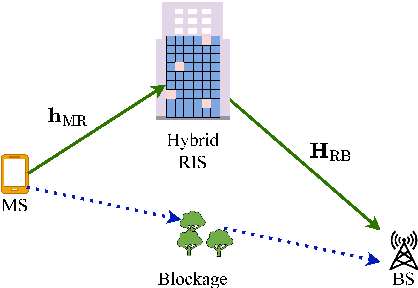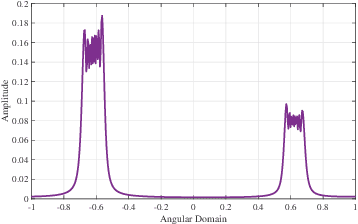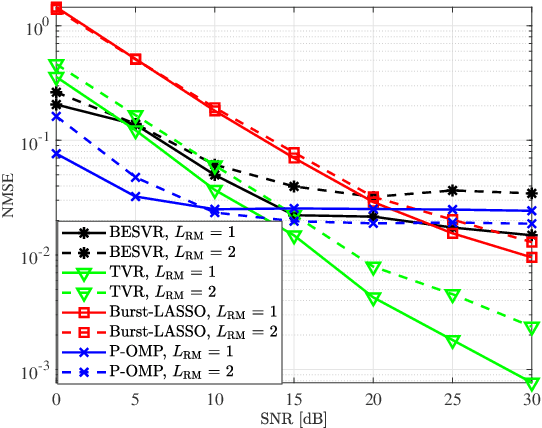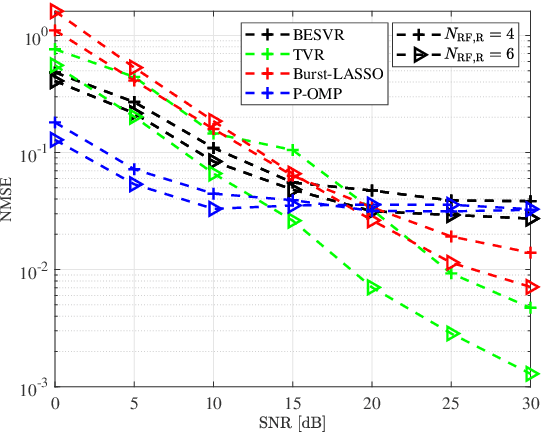Jiguang He
Multimodal Radio and Vision Fusion for Robust Localization in Urban V2I Communications
Aug 25, 2025Abstract:Accurate localization is critical for vehicle-to-infrastructure (V2I) communication systems, especially in urban areas where GPS signals are often obstructed by tall buildings, leading to significant positioning errors, necessitating alternative or complementary techniques for reliable and precise positioning in applications like autonomous driving and smart city infrastructure. This paper proposes a multimodal contrastive learning regression based localization framework for V2I scenarios that combines channel state information (CSI) with visual information to achieve improved accuracy and reliability. The approach leverages the complementary strengths of wireless and visual data to overcome the limitations of traditional localization methods, offering a robust solution for V2I applications. Simulation results demonstrate that the proposed CSI and vision fusion model significantly outperforms traditional methods and single modal models, achieving superior localization accuracy and precision in complex urban environments.
M2BeamLLM: Multimodal Sensing-empowered mmWave Beam Prediction with Large Language Models
Jun 17, 2025Abstract:This paper introduces a novel neural network framework called M2BeamLLM for beam prediction in millimeter-wave (mmWave) massive multi-input multi-output (mMIMO) communication systems. M2BeamLLM integrates multi-modal sensor data, including images, radar, LiDAR, and GPS, leveraging the powerful reasoning capabilities of large language models (LLMs) such as GPT-2 for beam prediction. By combining sensing data encoding, multimodal alignment and fusion, and supervised fine-tuning (SFT), M2BeamLLM achieves significantly higher beam prediction accuracy and robustness, demonstrably outperforming traditional deep learning (DL) models in both standard and few-shot scenarios. Furthermore, its prediction performance consistently improves with increased diversity in sensing modalities. Our study provides an efficient and intelligent beam prediction solution for vehicle-to-infrastructure (V2I) mmWave communication systems.
BeamLLM: Vision-Empowered mmWave Beam Prediction with Large Language Models
Mar 13, 2025Abstract:In this paper, we propose BeamLLM, a vision-aided millimeter-wave (mmWave) beam prediction framework leveraging large language models (LLMs) to address the challenges of high training overhead and latency in mmWave communication systems. By combining computer vision (CV) with LLMs' cross-modal reasoning capabilities, the framework extracts user equipment (UE) positional features from RGB images and aligns visual-temporal features with LLMs' semantic space through reprogramming techniques. Evaluated on a realistic vehicle-to-infrastructure (V2I) scenario, the proposed method achieves 61.01% top-1 accuracy and 97.39% top-3 accuracy in standard prediction tasks, significantly outperforming traditional deep learning models. In few-shot prediction scenarios, the performance degradation is limited to 12.56% (top-1) and 5.55% (top-3) from time sample 1 to 10, demonstrating superior prediction capability.
CardiacMamba: A Multimodal RGB-RF Fusion Framework with State Space Models for Remote Physiological Measurement
Feb 19, 2025Abstract:Heart rate (HR) estimation via remote photoplethysmography (rPPG) offers a non-invasive solution for health monitoring. However, traditional single-modality approaches (RGB or Radio Frequency (RF)) face challenges in balancing robustness and accuracy due to lighting variations, motion artifacts, and skin tone bias. In this paper, we propose CardiacMamba, a multimodal RGB-RF fusion framework that leverages the complementary strengths of both modalities. It introduces the Temporal Difference Mamba Module (TDMM) to capture dynamic changes in RF signals using timing differences between frames, enhancing the extraction of local and global features. Additionally, CardiacMamba employs a Bidirectional SSM for cross-modal alignment and a Channel-wise Fast Fourier Transform (CFFT) to effectively capture and refine the frequency domain characteristics of RGB and RF signals, ultimately improving heart rate estimation accuracy and periodicity detection. Extensive experiments on the EquiPleth dataset demonstrate state-of-the-art performance, achieving marked improvements in accuracy and robustness. CardiacMamba significantly mitigates skin tone bias, reducing performance disparities across demographic groups, and maintains resilience under missing-modality scenarios. By addressing critical challenges in fairness, adaptability, and precision, the framework advances rPPG technology toward reliable real-world deployment in healthcare. The codes are available at: https://github.com/WuZheng42/CardiacMamba.
A Simplified Algorithm for Joint Real-Time Synchronization, NLoS Identification, and Multi-Agent Localization
Dec 17, 2024



Abstract:Real-time, high-precision localization in large-scale wireless networks faces two primary challenges: clock offsets caused by network asynchrony and non-line-of-sight (NLoS) conditions. To tackle these challenges, we propose a low-complexity real-time algorithm for joint synchronization and NLoS identification-based localization. For precise synchronization, we resolve clock offsets based on accumulated time-of-arrival measurements from all the past time instances, modeling it as a large-scale linear least squares (LLS) problem. To alleviate the high computational burden of solving this LLS, we introduce the blockwise recursive Moore-Penrose inverse (BRMP) technique, a generalized recursive least squares approach, and derive a simplified formulation of BRMP tailored specifically for the real-time synchronization problem. Furthermore, we formulate joint NLoS identification and localization as a robust least squares regression (RLSR) problem and address it by using an efficient iterative approach. Simulations show that the proposed algorithm achieves sub-nanosecond synchronization accuracy and centimeter-level localization precision, while maintaining low computational overhead.
Low-Complexity Near-Field Channel Estimation for Hybrid RIS Assisted Systems
Apr 30, 2024



Abstract:We investigate the channel estimation (CE) problem for hybrid RIS assisted systems and focus on the near-field (NF) regime. Different from their far-field counterparts, NF channels possess a block-sparsity property, which is leveraged in the two developed CE algorithms: (i) boundary estimation and sub-vector recovery (BESVR) and (ii) linear total variation regularization (TVR). In addition, we adopt the alternating direction method of multipliers to reduce their computational complexity. Numerical results show that the linear TVR algorithm outperforms the chosen baseline schemes in terms of normalized mean square error in the high signal-to-noise ratio regime while the BESVR algorithm achieves comparable performance to the baseline schemes but with the added advantage of minimal CPU time.
Device-Free 3D Drone Localization in RIS-Assisted mmWave MIMO Networks
Apr 23, 2024



Abstract:In this paper, we investigate the potential of reconfigurable intelligent surfaces (RISs) in facilitating passive/device-free three-dimensional (3D) drone localization within existing cellular infrastructure operating at millimeter-wave (mmWave) frequencies and employing multiple antennas at the transceivers. The developed localization system operates in the bi-static mode without requiring direct communication between the drone and the base station. We analyze the theoretical performance limits via Fisher information analysis and Cram\'er Rao lower bounds (CRLBs). Furthermore, we develop a low-complexity yet effective drone localization algorithm based on coordinate gradient descent and examine the impact of factors such as radar cross section (RCS) of the drone and training overhead on system performance. It is demonstrated that integrating RIS yields significant benefits over its RIS-free counterpart, as evidenced by both theoretical analyses and numerical simulations.
Coverage and Rate Analysis for Integrated Sensing and Communication Networks
Mar 13, 2024



Abstract:Integrated sensing and communication (ISAC) is increasingly recognized as a pivotal technology for next-generation cellular networks, offering mutual benefits in both sensing and communication capabilities. This advancement necessitates a re-examination of the fundamental limits within networks where these two functions coexist via shared spectrum and infrastructures. However, traditional stochastic geometry-based performance analyses are confined to either communication or sensing networks separately. This paper bridges this gap by introducing a generalized stochastic geometry framework in ISAC networks. Based on this framework, we define and calculate the coverage and ergodic rate of sensing and communication performance under resource constraints. Then, we shed light on the fundamental limits of ISAC networks by presenting theoretical results for the coverage rate of the unified performance, taking into account the coupling effects of dual functions in coexistence networks. Further, we obtain the analytical formulations for evaluating the ergodic sensing rate constrained by the maximum communication rate, and the ergodic communication rate constrained by the maximum sensing rate. Extensive numerical results validate the accuracy of all theoretical derivations, and also indicate that denser networks significantly enhance ISAC coverage. Specifically, increasing the base station density from $1$ $\text{km}^{-2}$ to $10$ $\text{km}^{-2}$ can boost the ISAC coverage rate from $1.4\%$ to $39.8\%$. Further, results also reveal that with the increase of the constrained sensing rate, the ergodic communication rate improves significantly, but the reverse is not obvious.
Stochastic Geometry Analysis for Distributed RISs-Assisted mmWave Communications
Mar 10, 2024



Abstract:Millimeter wave (mmWave) has attracted considerable attention due to its wide bandwidth and high frequency. However, it is highly susceptible to blockages, resulting in significant degradation of the coverage and the sum rate. A promising approach is deploying distributed reconfigurable intelligent surfaces (RISs), which can establish extra communication links. In this paper, we investigate the impact of distributed RISs on the coverage probability and the sum rate in mmWave wireless communication systems. Specifically, we first introduce the system model, which includes the blockage, the RIS and the user distribution models, leveraging the Poisson point process. Then, we define the association criterion and derive the conditional coverage probabilities for the two cases of direct association and reflective association through RISs. Finally, we combine the two cases using Campbell's theorem and the total probability theorem to obtain the closed-form expressions for the ergodic coverage probability and the sum rate. Simulation results validate the effectiveness of the proposed analytical approach, demonstrating that the deployment of distributed RISs significantly improves the ergodic coverage probability by 45.4% and the sum rate by over 1.5 times.
Hashing Beam Training for Near-Field Communications
Mar 10, 2024Abstract:In this paper, we investigate the millimeter-wave (mmWave) near-field beam training problem to find the correct beam direction. In order to address the high complexity and low identification accuracy of existing beam training techniques, we propose an efficient hashing multi-arm beam (HMB) training scheme for the near-field scenario. Specifically, we first design a set of sparse bases based on the polar domain sparsity of the near-field channel. Then, the random hash functions are chosen to construct the near-field multi-arm beam training codebook. Each multi-arm beam codeword is scanned in a time slot until all the predefined codewords are traversed. Finally, the soft decision and voting methods are applied to distinguish the signal from different base stations and obtain correctly aligned beams. Simulation results show that our proposed near-field HMB training method can reduce the beam training overhead to the logarithmic level, and achieve 96.4% identification accuracy of exhaustive beam training. Moreover, we also verify applicability under the far-field scenario.
 Add to Chrome
Add to Chrome Add to Firefox
Add to Firefox Add to Edge
Add to Edge